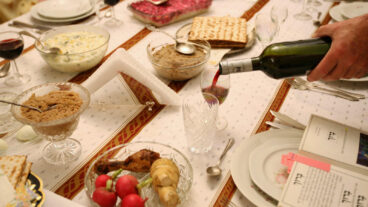The algorithms for date conversion are surprisingly concise, considering the complicated math on which they are based. (Illustration: Pnina Wolinsky-Sissman)The e-mail came from a Swede requesting that Tel Aviv University Professor Nachum Dershowitz look into the rules of the Samaritan calendar “since he was already there in Israel.”
Thus began the latest odyssey of Dershowitz, a member of the School of Computer Science, Raymond and Beverly Sackler Faculty of Exact Sciences, in systemizing yet another of the world’s dating systems – this time of a secretive, traditionalist religious sect of only 1,000 people that live in a radius of about 65 mile radius from the TAU campus.
To date, Dershowitz and his colleague Prof. Edward M. Reingold of the Illinois Institute of Technology, USA, have mathematically analyzed 25 of the world’s calendars in the first and only project of its kind. They have provided equations and algorithms for quick and accurate calculation of dates within each system, as well as for conversion of dates between calendars.
The second edition of their book, Calendrical Calculations, encodes the rules for two dozen calendars in mathematical form, and describes how they relate to one another. Among the systems described are the Gregorian (in near universal use today), Islamic, Persian, Coptic, Baha’i, Hebrew, Mayan, Chinese, and modern Hindu. (www.calendarists.com)
“When you want to know in advance whether a particular date is a holiday, or when Ramadan will be in 2010, or how to convert the Chinese New Year into a date in the Jewish calendar,” Dershowitz says, “the calculations can be very intricate.”
What he and Reingold did was to define for several major calendar groups exactly how they can be computed. Their algorithms for date conversion are surprisingly concise, considering the complicated math on which they are based.
One problem solved by the calendrical algorithms is rampant errors in computer software. Leap years were inserted into spreadsheet programs where they shouldn’t be, and daylight savings times were miscalculated in computer operating systems. Now, the researchers’ accurate dating and conversion tools are used in business, communications, genealogical and diary software.
Dershowitz notes that, for the Chinese calendar, there had been no calculations in a Western language beforehand. For the difficult, geographically-based Indian calendars – which can vary from province to province – there had never been an attempt to program them.
But the best story by far involves the Persian calendar. Like the Gregorian calendar, the Persian calendar is solar, but the lengths of the months are calculated differently, as are leap days and leap years. Using library resources and faxed messages with an official in Tehran, Dershowitz and Reingold cracked the system, simplified it, and wrote up the math.
Their solutions were so elegant that the government of Iran invited them to attend a conference there – the first time that American-born scientists were asked to visit since the fall of the Shah in 1979.
Their calendrical calculations are also being used by computer scientist W. Daniel Hillis, laureate of Tel Aviv University’s 2002 Dan David Prize, who is building a clock for all time. His ‘10,000 year’ clock synchronizes the date-keeping systems of many cultures and displays various calendar systems such as the Mayan, Muslim and Hindu ones.
(Courtesy of Tel Aviv University)











